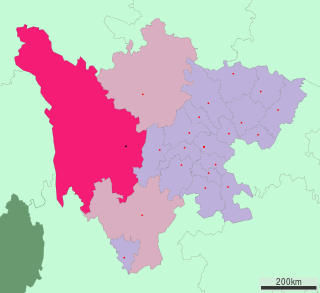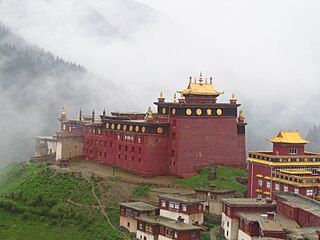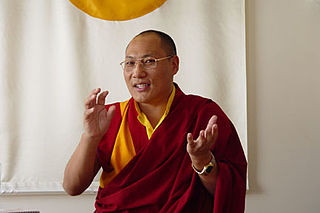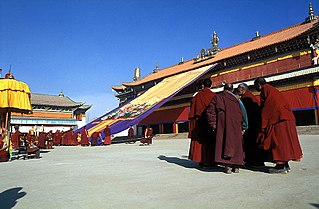
Tibetan Buddhism is a form of Buddhism practiced in Tibet and Mongolia. It also has a sizable number of adherents in the areas surrounding the Himalayas, including the Indian regions of Ladakh, Sikkim, and Arunachal Pradesh, as well as Bhutan and Nepal. Smaller groups of practitioners can be found in Central Asia, Xinjiang, Inner Mongolia, and some regions of Russia, such as Tuva, Buryatia, and Kalmykia.
Tai Situpa is one of the oldest lineages of tulkus in the Kagyu school of Tibetan Buddhism In Tibetan Buddhism tradition, Kenting Tai Situpa is considered as emanation of Bodhisattva Maitreya and Guru Padmasambhava and who has been incarnated numerous times as Indian and Tibetan yogis since the time of the historical Buddha.

Nyingma, often referred to as Ngangyur, is the oldest of the four major schools of Tibetan Buddhism. The Nyingma school is founded on the first lineages and translations of Buddhist scriptures from Sanskrit into Tibetan in the eighth century, during the reign of King Trisong Detsen.

Lobsang Trinley Lhündrub Chökyi Gyaltsen was the tenth Panchen Lama, officially the 10th Panchen Erdeni, of the Gelug school of Tibetan Buddhism. According to Tibetan Buddhism, Panchen Lamas are living emanations of the buddha Amitabha. He was often referred to simply as Choekyi Gyaltsen.
Free Tibet (FT) is a non-profit, non-governmental organisation, founded in 1987 and based in London, England. According to their mission statement, Free Tibet advocates for "a free Tibet in which Tibetans are able to determine their own future and the human rights of all are respected."

Kyabje Khenchen Jigme Phuntsok,, was a Nyingma lama and Terton from Sertha Region. His family were Tibetan nomads. At the age of five he was recognized "as a reincarnation of Lerab Lingpa. Known also as Nyala Sogyel and Terton Sogyel, Lerab Lingpa was an eclectic and highly influential tantric visionary from the eastern Tibetan area of Nyarong ." He studied Dzogchen at Nubzor Monastery, received novice ordination at 14, and full ordination at 22. In 1980, he founded Larung Gar, the largest Tibetan Buddhist monastic academy.

Larung Gar in the Larung Valley is a community in Sêrtar County of Garzê Tibetan Autonomous Prefecture, in Sichuan, China, known as Kham. Larung Gar is the local name for the community of mostly Tibetan and Han Chinese students which grew around the Serta Larung Five Science Buddhist Academy, founded in 1980 by Kyabje Khenchen Jigme Phuntsok. The residents are monks, nuns, vow holders and lay people. Larung Gar was considered the largest Buddhist monastic center until demolitions by the Chinese government recommenced in July 2016.

In 1980, Kyabje Khenchen Jigme Phuntsok founded Larung Gar, which was officially named by the 10th Panchen Lama in 1987 as Serta Larung Five Science Buddhist Academy, also known of in Tibetan: བླ་རུང་ལྔ་རིག་ནང་བསྟན་སློབ་གླིང་།, ZYPY: Serta Larung Ngarig Nangdän Lobling,, located in the Larung Valley (喇荣沟) near the township of Larung in Sêrtar County, Garzê Prefecture, Sichuan Province, known of as Kham. The Serta Larung Five Science Buddhist Academy grew from Khenchen Jigme Phuntsok's mountain retreat. The purpose of Larung Gar's Academy is to provide an ecumenical training in Tibetan Buddhism and to meet the need for renewal of meditation, ethics, and scholarship all over Tibet in the wake of China's Cultural Revolution of 1966-76.
Geshe or geshema is a Tibetan Buddhist academic degree for monks and nuns. The degree is emphasized primarily by the Gelug lineage, but is also awarded in the Sakya and Bön traditions. The equivalent geshema degree is awarded to women.

Dzogchen Monastery is one of the "Six Mother Monasteries" of the Nyingma tradition of Tibetan Buddhism. It is located in Kham within modern day Dêgê County, Garzê Tibetan Autonomous Prefecture, Sichuan, China.

Garzê Tibetan Autonomous Prefecture, often shortened to Ganzi Prefecture, is an autonomous prefecture in the western arm of Sichuan province, China bordering Yunnan to the south, the Tibet Autonomous Region to the west, and Gansu to the north and northwest.

Yushu Tibetan Autonomous Prefecture, also transliterated as Yüxü or Yulshul, is an autonomous prefecture of Southwestern Qinghai Province, China. Largely inhabited by Tibetans, the prefecture has an area of 188,794 square kilometres (72,894 sq mi) and its seat is located in the town of Gyêgu in Yushu County, which is the place of the old Tibetan trade mart of Jyekundo. The official source of the Yellow River lies within the prefecture. Historically, the area belongs to the cultural realm of Kham in Eastern Tibet.

Palpung Monastery is the name of the congregation of monasteries and centers of the Tai Situpa lineage of the Kagyu school of Tibetan Buddhism as well as the name of the Tai Situ's monastic seat in Babang, Kham. Palpung means "glorious union of study and practice". It originated in the 12th century and wielded considerable religious and political influence over the centuries.

Khenpo Sherab Sangpo

Sêrtar County or Serthar County is a county in the northwest of Sichuan Province, China, bordering Qinghai province to the north. It is one of the 18 counties under the administration of the Garzê Tibetan Autonomous Prefecture, covering some 9,340 square kilometres. Sêrtar, which means "golden freedom" in Tibetan, lies in the southeast of the Tibetan Plateau and in the historical region of Kham. The vast majority of the population is Tibetan, followed by Han Chinese.
Sershul Monastery (སེར་ཤུལ་དགོན།) is situated on the Tibetan Plateau at an elevation of 4,000 metres (13,000 ft). The Tibetan Buddhist monastery is located in the Garzê Tibetan Autonomous Prefecture of Sichuan Province, near where the borders of the Tibet Autonomous Region and Qinghai Province meet.

Kirti Gompa, is a Tibetan Buddhist monastery founded in 1472 and located in Ngawa, Sichuan province, in China, but traditionally part of Amdo region. Numerous other associated Kirti monasteries and nunneries are located nearby. As of March 2011, the Kirti Gompa was said to house 2,500 monks. Between 2008 and 2011, mass arrests and patriotic re-education programs by Chinese authorities have targeted the monks, reducing the population substantially to 600 monks. The wave of Tibetan self-immolations began at Kirti Gompa.

Chen Quanguo is a retiring Chinese politician and the current deputy head of the CCP Central Rural Work Leading Group. Between 2017 and 2022, he was a member of the 19th Politburo of the Chinese Communist Party and was previously the Chinese Communist Party Committee Secretary of Tibet Autonomous Region from 2011 to 2016 and of the Xinjiang Uyghur Autonomous Region from 2016 to 2021, making him the only person to serve as the Party Secretary for both autonomous regions. Chen was also Political Commissar of the Xinjiang Production and Construction Corps concurrently with his position as Xinjiang Party Secretary.

Tibet on Fire: Self-Immolations Against Chinese Rule is a book written by Tsering Woeser, published by Verso Books in 2016. The book is a contemporary look at a major social and human rights problem caused by the forced integration of Tibetan and Chinese societies, and due to empirically repressive policies of the Chinese (PRC) government.

Antireligious campaigns in China refer to the Chinese Communist Party's official promotion of state atheism, coupled with its persecution of people with spiritual or religious beliefs, in the People's Republic of China. Antireligious campaigns were launched in 1949, after the Chinese Communist Revolution, and they continue to be waged against Buddhists, Christians, Muslims, and members of other religious communities in the 21st century. State campaigns against religion have escalated since Xi Jinping became General Secretary of the Chinese Communist Party on November 15, 2012. For Christians, government decrees have mandated the widespread removal of crosses from churches, and in some cases, they have also mandated the destruction of houses of worship, such as the Catholic Three Rivers Church in the city of Wenzhou. In Tibet, similar decrees have mandated the destruction of Tibetan Buddhist monastic centers, the destruction of sacred Buddhist sites, the destruction of monastic residences, the denial of the Tibetan people's right to freely access their cultural heritage, the ongoing persecution of high Buddhist lamas and the ongoing persecution of Buddhist nuns and monks. Reports which document the existence of forced re-education camps, arrests, beatings, rape, and the destruction of religious sites in Tibet are also being published with regard to the Uyghur people, who are being subjected to an ongoing genocide.
















